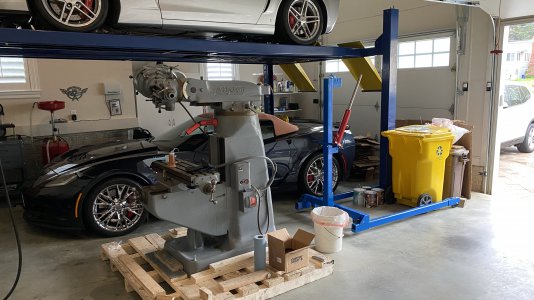-
Welcome back Guest! Did you know you can mentor other members here at H-M? If not, please check out our Relaunch of Hobby Machinist Mentoring Program!
You are using an out of date browser. It may not display this or other websites correctly.
You should upgrade or use an alternative browser.
You should upgrade or use an alternative browser.
Franko's Hf Engine Hoist Mod
- Thread starter Franko
- Start date
- Joined
- Oct 16, 2014
- Messages
- 318
Hmm... not seeing it.With a load of 2000 lbs hanging from the hook, the torsion on the weld joint will be something like 4 * 2000 = 8000 foot lbs. That's a scary large number to be held by just a couple of weld joints!
The arm and hydraulics are all suspended by pin joints, not welds. So you really don't get to say something as simple as 8K ft-lbf moment and shiver in fear. In fact, the arm will be pointed upward at a pretty steep angle, to get on top of the machine (and pallet) so you get to work up a full truss load diagram first, then declare reactions. Which is also why I think just blocking the back end will far more than suffice if it's even needed at all.
And I'm taking at face value a 1/4" wall thickness on a 2" square tube which, while inefficient to be held in bending (or torsion), it will take a lot - I mean big scary numbers - well before failure.
My prediction is twofold:
1. The hydraulics will give out first if it's an overload condition. Simply because in our litigious society, the tubing is doubtless over-engineered for all possible conditions.
2. In the time we discuss it, he'll probably already have it unloaded and wonder what all the hubbub is about.
Also wanna reiterate that this is for a one-off operation of raising maybe a half-inch and lowering the depth of a pallet after yanking the pallet, not moving the machine. HUGE loads occur when a hoist like this starts moving across the floor. Every crack in the concrete is a 2 or 3 g multiplier, which is what the original designers (and lawyers) already knew. So for use as a general hoist, yes, I totally agree with you and everyone else about the myriad concerns. No contest. I'll be as scared as anyone. But for this singular operation, I'm sure it'll not only go smooth, but if something starts getting wonky, he can abort the mission and just leave it on the pallet.
.
- Joined
- Jul 15, 2020
- Messages
- 422
- Joined
- Oct 16, 2014
- Messages
- 318
Now that I see the mill and my engine hoist side by side, there's no way I'm going to try to lift it with that hoist. I guess I will have to get inventive with a toe jack, some blocks, and a reciprocal saw.
Smart thinking. Good judgment.
- Joined
- Feb 17, 2013
- Messages
- 4,409
Hmmmm ... wild and crazy idea ...
Move the two cars away from the car hoist. Raise it, empty, to about where it is now. Lay a stout beam across it. Use a pallet jack (or pipe rollers) to position the mill under the hoist. Rig lifting slings. Lift it just enough to hold the pallet above the floor. Remove pallet. Attach stout bars, equipped with adjustable feet, across the bottom of the mill. Adjust the feet to raise the bars high enough for the pallet jack. Set the mill on the ground. Use the pallet jack to move the mill into position. Lower the feet as much as possible while leveling the mill.
See post #51 at: https://www.hobby-machinist.com/threads/base-feet-for-a-bridgeport.1362/page-6 That's how I did it on my knee mill.
These are the leveling feet I bought: https://www.mcmaster.com/catalog/127/1560 Part number 6111K191
Move the two cars away from the car hoist. Raise it, empty, to about where it is now. Lay a stout beam across it. Use a pallet jack (or pipe rollers) to position the mill under the hoist. Rig lifting slings. Lift it just enough to hold the pallet above the floor. Remove pallet. Attach stout bars, equipped with adjustable feet, across the bottom of the mill. Adjust the feet to raise the bars high enough for the pallet jack. Set the mill on the ground. Use the pallet jack to move the mill into position. Lower the feet as much as possible while leveling the mill.
See post #51 at: https://www.hobby-machinist.com/threads/base-feet-for-a-bridgeport.1362/page-6 That's how I did it on my knee mill.
These are the leveling feet I bought: https://www.mcmaster.com/catalog/127/1560 Part number 6111K191

